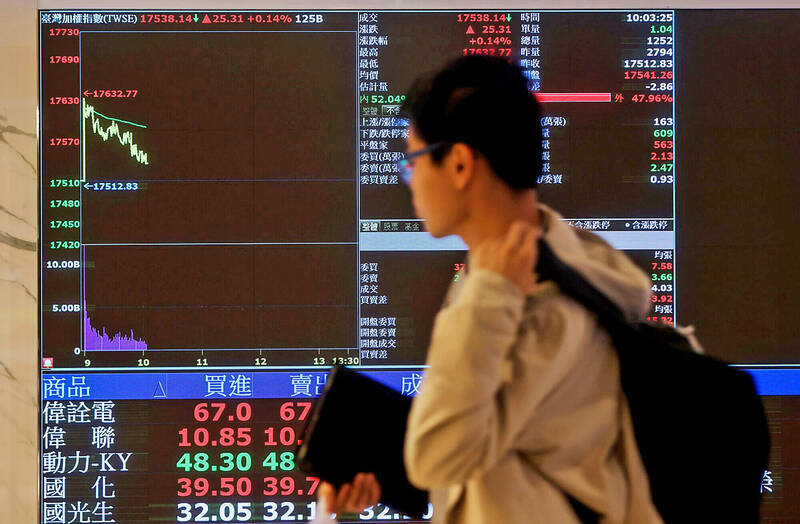Fewer retail investors entered the local stock market in the fourth quarter of last year, while more institutional investors, foreign and domestic, pushed ahead after technical consolidation in the market ended, data compiled by the Taiwan Stock Exchange (TWSE) showed on Monday.
During the October-to-December quarter, retail investors accounted for 55.96 percent of the local market’s turnover, down from 59.01 percent in the previous quarter, the exchange said in a statement.
In contrast, foreign institutional investors made up 32.74 percent of the exchange’s turnover, up 1.97 percentage points from the previous quarter, while domestic institutional investors represented the remaining 11.3 percent, up 1.08 percentage points, the TWSE said.

Photo: Bloomberg
Although market sentiment improved after November, and the TAIEX rose 1,577.07 points in the final quarter of last year, retail investors favored safer investment approaches, with dollar-cost averaging investments gaining NT$442 million (US$14.1 million) to NT$9.78 billion last month from the previous month, the exchange’s data showed.
Dollar-cost averaging is the practice of investing a fixed-dollar amount on a regular basis, regardless of the share price. It has become more popular among retail investors investing in high-dividend exchange-traded funds or local stocks with stable dividends, the exchange said.
Among retail investors, 2,973 “big players” participated in the local market in the fourth quarter, down 523 from a seven-quarter high of 3,496 in the previous quarter, TWSE data showed.
A “big player” is defined as an investor who trades at least NT$500 million in shares on the TWSE in a single quarter.
The number of “midsized players” — or retail investors with quarterly turnover of between NT$100 million and NT$500 million — decreased to 23,604 last quarter from 28,597 the previous quarter, while that of “small players,” with quarterly trading of less than NT$100 million, also fell to 4.34 million from 4.51 million, the data showed.
The exchange’s latest data are seen as an important indicator of investor confidence in Taiwanese equities, after the TAIEX’s robust performance last year, with a full-year gain of 3,793 points, or 26.7 percent.
The TAIEX yesterday closed down 199.95 points, or 1.14 percent, in line with other regional indices as concerns about geopolitical risks and Taiwan’s new political landscape after Saturday’s elections overshadowed hopes for an early US Federal Reserve interest rate cut, Capital Investment Management Corp (群益投顧) said in a note yesterday.
The index has dropped 2.14 percent so far this year.

The US dollar was trading at NT$29.7 at 10am today on the Taipei Foreign Exchange, as the New Taiwan dollar gained NT$1.364 from the previous close last week. The NT dollar continued to rise today, after surging 3.07 percent on Friday. After opening at NT$30.91, the NT dollar gained more than NT$1 in just 15 minutes, briefly passing the NT$30 mark. Before the US Department of the Treasury's semi-annual currency report came out, expectations that the NT dollar would keep rising were already building. The NT dollar on Friday closed at NT$31.064, up by NT$0.953 — a 3.07 percent single-day gain. Today,

‘SHORT TERM’: The local currency would likely remain strong in the near term, driven by anticipated US trade pressure, capital inflows and expectations of a US Fed rate cut The US dollar is expected to fall below NT$30 in the near term, as traders anticipate increased pressure from Washington for Taiwan to allow the New Taiwan dollar to appreciate, Cathay United Bank (國泰世華銀行) chief economist Lin Chi-chao (林啟超) said. Following a sharp drop in the greenback against the NT dollar on Friday, Lin told the Central News Agency that the local currency is likely to remain strong in the short term, driven in part by market psychology surrounding anticipated US policy pressure. On Friday, the US dollar fell NT$0.953, or 3.07 percent, closing at NT$31.064 — its lowest level since Jan.

The New Taiwan dollar and Taiwanese stocks surged on signs that trade tensions between the world’s top two economies might start easing and as US tech earnings boosted the outlook of the nation’s semiconductor exports. The NT dollar strengthened as much as 3.8 percent versus the US dollar to 30.815, the biggest intraday gain since January 2011, closing at NT$31.064. The benchmark TAIEX jumped 2.73 percent to outperform the region’s equity gauges. Outlook for global trade improved after China said it is assessing possible trade talks with the US, providing a boost for the nation’s currency and shares. As the NT dollar

The Financial Supervisory Commission (FSC) yesterday met with some of the nation’s largest insurance companies as a skyrocketing New Taiwan dollar piles pressure on their hundreds of billions of dollars in US bond investments. The commission has asked some life insurance firms, among the biggest Asian holders of US debt, to discuss how the rapidly strengthening NT dollar has impacted their operations, people familiar with the matter said. The meeting took place as the NT dollar jumped as much as 5 percent yesterday, its biggest intraday gain in more than three decades. The local currency surged as exporters rushed to